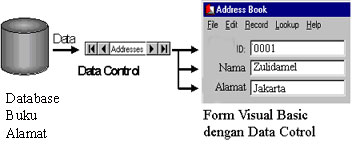Cara 1. Menggunakan Object ADO
Anda dapat menggunakan icon Adodc (Microsoft ActiveX Data Objects Data Control) pada toolbox. Jika pada toolbox tidak terdapat icon Adodc, Anda dapat menambahkannya dengan memilih menu Project, Components (Ctrl+T) lalu beri tanda pilih pada Microsoft ADO Data Control (OLEDB) dan klik Apply. Sekarang kita akan mencoba mengaitkan database Ms. Acess yang diberi nama Pembelian.mdb. Untuk itu, lakukan langkah-langkah sebagai berikut:
- Pilih menu File lalu New.
- Pilih VB Enterprise (Professional) Edition Controls.
- Klik OK.
- Klik ganda pada folder Forms pada jendela proyek lalu klik ganda pada Form 1 sampai muncul tampilan form.
- Klik icon Adodc pada toolbox.
- Klik dan seret pada jendela form, sehingga muncul tampilan seperti Gb. Objek yang tergambar dalam form disebut objek data.
- Tentukan properti data sebagai berikut:
- Name db Pembelian
- Caption Data Barang
- EOFAcction 2
- Tentukan properti ConnectionString dengan cara mengklik tombol … pada kolom ConnectionString sehingga muncul tam pilan seperti pada Gb
- Pilih OptionButton pada Use Connection String lalu klik Build sehingga muncul tampilan seperti pada Gb
- Pilih Microsoft Jet 4.0 OLEDB Provider lalu klik Next.
- Pilih (dengan mengklik tombol …) atau ketik nama database yang dipakai pada kolom Select or enter a database name.
- Klik Test Connection jika perlu, lalu kllk OK dua kali sampai tampilan kembali ke jendela Form.
- Tentukan properti RecordSource dengan cara mengklik tombol pada kolom RecordSource sehingga muncul tampilan seperti pada Gb
- Pada kolom Command Type pilih 2-adCmdTable. Setelah kolom ini diisi, maka Anda akan dapat mengisi kolom Table or Stored Procedure Name. lsilah dengan memilib tabel Barang seperti pada Gb
- Klik OK.
- Simpan form dan proyek dengan nama VB-Lat-01
Cara 2: Mendeklarasikan Objek Ado
Object ado dapat dideklarasi melalui coding. Tiga object bawaan ADO dalam pengembangan aplikasi adalah :
1. Obcet Connection
untuk menangani koneksi antara program dengan sumber data atau server. Deklarasi dapat bersifat lokal maupun global serta dapat diletakan pada level form, modul atau class modul. ADO paling umum membuka suatu koneksi dengan menggunakan obyek Connection Open metoda. Sintaks untuk Metoda Open ditunjukkan sbb:
Dim connection as New ADODB.Connection
connection.
OpenConnectionString, UserID, Password, OpenOptions
Sebagai alternatif, anda dapat menggunakan teknik pintas, recordset.Open, untuk membuka koneksi yang tersembunyi dan mengeluarkan suatu perintah atas koneksi dalam satu operasi. Lakukan hal ini dengan mengaktivkan suatu koneksi yang valid seperti argumentasi ActiveConnection ke Metoda Open. Ini adalah sintaksis untuk masing-masing metoda di Visual Basic:
Dim recordset as ADODB.Recordset Set
recordset = New ADODB.Recordset
recordset.
OpenSource, ActiveConnection, CursorType, LockType, OptionsContoh :
Deklarasi object Connection:
Dim cn As New ADODB.Connection
atau
Public cn As New ADODB.connection
Selanjutnya mengalokasikan memori untuk onject connection sbb:
Set cn = New ADODB.Connection
Kemudian isi property object connoction tersebut sbb:
Contoh berikut adalah property untuk MSSQL Server
cn.connectionString = “Perovider=SQLOLEDB;” & _
”Server=NamaServer; ” & _
“Initial catalog= inventory” & _
“user Id = zulidamel” _
“Password=terserah”
cn.Open
atau
koneksi = “Perovider=SQLOLEDB;” & _
”Server=NamaServer; ” & _
“Initial catalog= inventory” & _
“user Id = zulidamel” _
“Password=terserah”
cn.Open koneksi
Jika tidak ingin menggunak authentik pada proses koneksi gunakan cara berikut:
koneksi = “Provider=SQLOLEDB.1;” & _
“Integrated Security Info=False;” & _
“Data Source = NamaServer” cn.Open koneksiBila koneksi sudah tidak diperlukan tutuplah koneksi dengan perintah
”Set cn = Nothing”
2. Object Command
Digunakan untuk perintah SQL ke sumber data atau server. Deklarasi object command sbb:
Dim CmdBarang As New ADODB.Command
atau
Public Cmd as New ADODB.Command
selanjutnya alokasikan memori untuk object Command sbb:
Set CmdBarang = New ADODB.Command
Kemudian Isi property object command
CmdBarang.ActiveConection = cn
CmdBarang.CommandText = “select * from barang”
CmdBarang.CommandType = adCmdText
3. Object Recordset
Digunakan sebagao penampung hasil eksekusi dalam bentuk tabel. Deklarasi object record sbb:
Dim rsBarang As New ADODB.Recordset
atau
Public rsBarang As New ADODB.Recordset
selanjutnya alokasikan memori ynryk object recordset sbb:
Set rsBarang = New ADODB.recordset
lalu isikan property object record set
rsBarang.CusrsorTYpe = adOpenDynamic
rsBarang.LockType = adLockOptimistic
rsbarang.Open cmdBarang
atau
rsbarang,open CmdBarang,, adOpenDynamic, adlockOptimistic, adCmdtext
Data Control
Visual Basic terus berkembang dalam pengembangan general purpose Windows, tetapi kemampuan database tidaklah bagian murni dari desainnya. Data Control, Visual Basic menambahkan, membuat Visual Basic suatu alat yang jauh lebih tangguh untuk pembuatan pemrograman database.
 Data Control memberikan kemudahkan untuk mendapat data ke dalam program anda. Anda dapat dengan mudah mengaitkan suatu file database, lalu mengaitkan data lainnya untuk memindahkan data dari database ke aplikasi anda dan sebaliknya. Data Control pada suatu database dan menetapkan tabel mana yang akan diambil, lalu mengaitkan ke pengendali Data Control, menetapkan field yang akan ditampilkan. Pada waktu itu aplikasi anda dapat mengambil, menampilkan, memperbaharui dan membuat database merekam. Alir data di dalam skenario ini ditandai pada gambar.
Data Control memberikan kemudahkan untuk mendapat data ke dalam program anda. Anda dapat dengan mudah mengaitkan suatu file database, lalu mengaitkan data lainnya untuk memindahkan data dari database ke aplikasi anda dan sebaliknya. Data Control pada suatu database dan menetapkan tabel mana yang akan diambil, lalu mengaitkan ke pengendali Data Control, menetapkan field yang akan ditampilkan. Pada waktu itu aplikasi anda dapat mengambil, menampilkan, memperbaharui dan membuat database merekam. Alir data di dalam skenario ini ditandai pada gambar.




